Intel Alder Lake-H Core i9-12900HK Review: MSI's Raider GE76 Goes Hybrid
by Brett Howse on January 25, 2022 9:00 AM EST- Posted in
- CPUs
- Intel
- MSI
- Laptops
- Alder Lake
- GE76 Raider
- 12th Gen Core
- Alder Lake-H
System Performance: Hybrid CPU Design
With the new hybrid CPU design available in Alder Lake there are now 20 threads available. The system features six P-Core, and each P-Core offers simultaneous multithreading with two threads per core, meaning there are twelve threads available on the P-Cores. The E-Cores are single-threaded only, and there are eight E-Cores. The new Thread Director from Intel coupled with Windows 11’s thread scheduler is aware of the cores being high-performance and low-performance and will tend to assign work accordingly; but if the system is not busy and the workload is in the foreground and multi-threaded, it will schedule threads across all 20 cores if needed. If an active task is moved to the background by the user, by either minimizing the task or opening another workload, the background task is allocated to the E-Cores and the P-Cores are prioritized for user-focused work.
This means that even on a heavily loaded system, system responsiveness should be maintained, and although the user will not have their full system performance available, the P-Cores will be prioritized for active workloads instead of background tasks. For our standard performance testing, benchmarks are always run as the only active task so that the results are representative, but for this review we will also cover some multi-tasking scenarios in a bit.
To test system performance, the system was set to dedicated graphics mode since this is the way most Desktop Replacement systems will be run, and the MSI laptop was set to its maximum performance setting.
PCMark 10

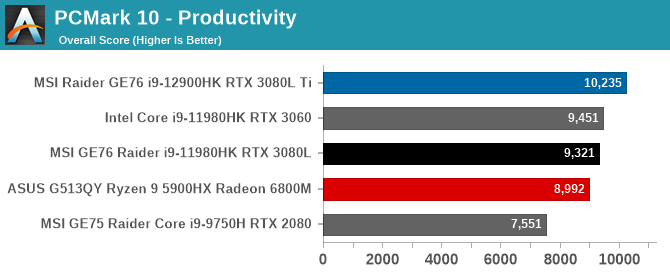
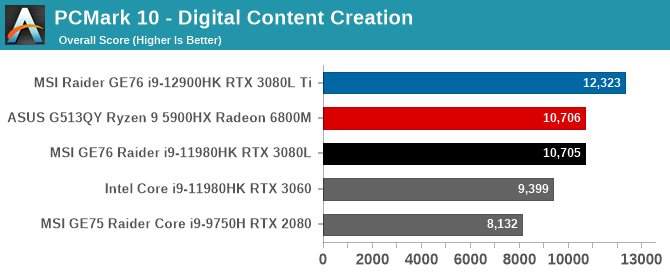
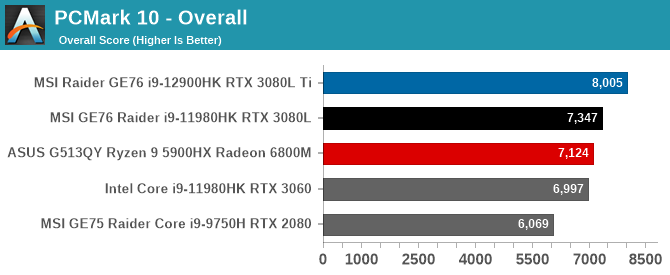
UL’s PCMark is a full-system benchmark which not only measures CPU performance, but also memory, storage, and graphics. It is being included as a reference since we always include it in laptop reviews, but be aware that the MSI Raider GE76 now offers the RTX 3080L Ti GPU, which is a step above the RTX 3080L found in the 2021 MSI GE76 Raider. As with all laptop testing, it is almost impossible to have a completely apples to apples comparison. The Raider GE76 also ships with much faster DDR5-4800 memory, an advantage of the Alder Lake platform.
That being said, the new Alder Lake system is by far the quickest notebook we have ever tested on PCMark 10. Some of that is CPU, and some is GPU, and some is memory, and some is storage. As was said at the start, Intel is putting their best foot forward, and it is hard to blame them.
Cinebench R20
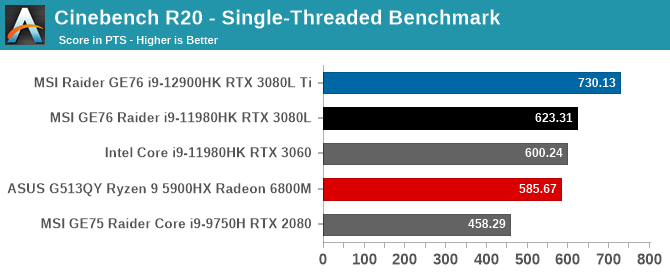
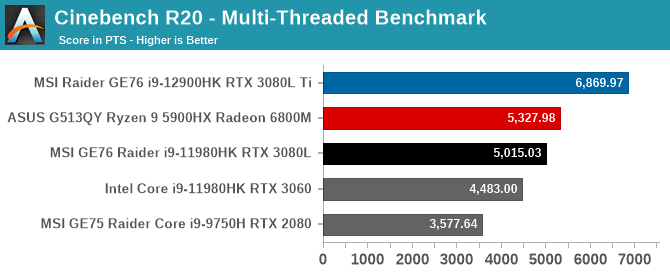
Always a popular benchmark due to its ease of use and ability to set the test to be single-threaded or multi-threaded, Cinebench is more of a pure CPU test since it does not leverage the GPU at all and is not very memory intensive.
Tiger Lake had a small single-threaded performance lead over the latest Ryzen processors, and Alder Lake simply smashes both of them. The single-threaded performance uplift is seriously impressive.
On the multi-threaded side, AMD’s better power efficiency with Ryzen allowed them to pull ahead in the past, but now that Alder Lake features 20 threads compared to 16 in the Ryzen 9 5900HX, the Core i9-12900HK pulls well in front with all threads loaded. This is despite it having only twelve threads of performance cores, so the eight E-Cores are definitely pulling their weight here.
Handbrake

Probably the most popular transcoding tool around, Handbrake has support for software-based transcoding as well has hardware-based with support for AMD’s VCE, NVIDIA’s NVENC and Intel QuickSync. We test by doing a transcode of a 1080p Blu-Ray rip to 720p with the same quality settings for all encoders. For most transcoding, software transcoding tends to yield the best quality, however the specialty hardware can often complete the task in less time.
As a heavily multithreaded task, AMD’s Cezanne platform was our previous champ here, but Alder Lake demolishes the previous results. The new Golden Cove / Gracemont combination offers an almost 30% uptick compared to Tiger Lake in the same chassis. If you peek down to the Hardware transcode graph, you will see that the new Alder Lake platform is actually quicker at this particular test than the QuickSync was on Tiger Lake. Very impressive.
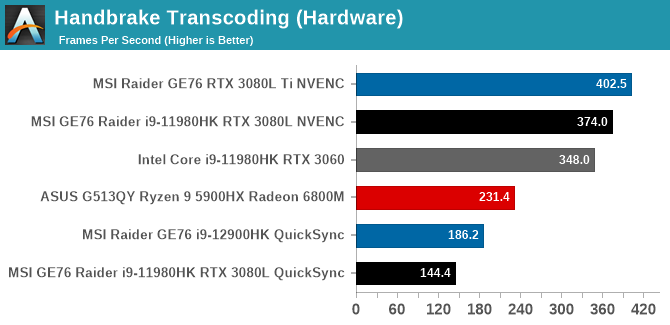
Speaking of hardware transcoding, Intel’s QuickSync does get a bump over Tiger Lake’s implementation, but perhaps unsurprisingly they are smashed by the NVIDIA encoders in the big graphics cards installed in the MSI Raider systems.
7-Zip
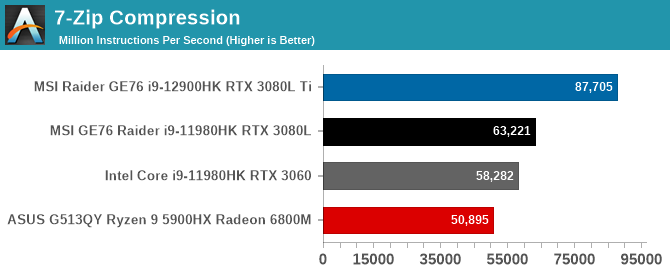
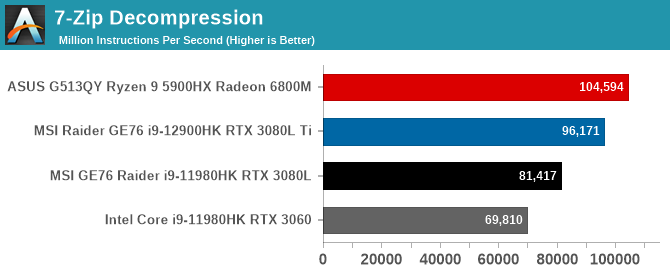
Despite a massive uplift in compression speed in the Core i9-12900HK, Intel isn’t quite able to wrestle the decompression crown away from AMD’s Ryzen 9 5900HX, although it is much, much closer than it was before.
Web Tests
Although web performance is an integral part of most people’s lives now, testing web performance is both testing the CPU performance as well as the browser’s scripting engine. As such, to be as consistent as possible, all web benchmarks are run on the current version of Microsoft Edge, which is based on the Chromium web browser. However, updates to the browser which happen very frequently could impact performance, so any results we have in our database are snapshots from the time that laptop was reviewed. For now, with the decommissioning of several popular browser benchmarks, we are focusing on Speedometer 2.0 from Webkit, and WebXPRT 3 from Principled Technologies. WebXPRT 4 is in preview now, and once it launches, we will take a look at it for future reviews.
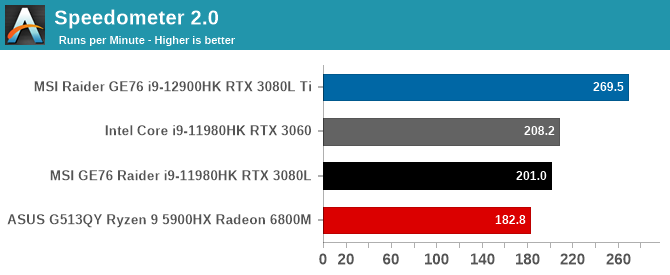
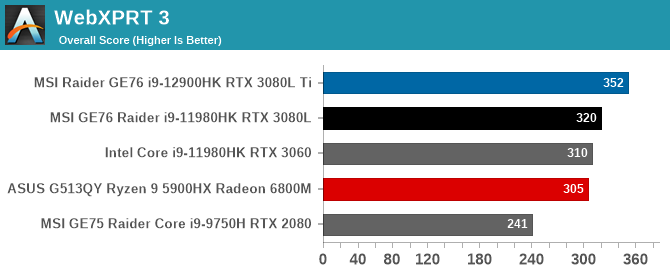
Web performance is often dependent on single-threaded performance, as well as how quickly a processor can ramp up to maximum performance. Both AMD and Intel have made big improvements in how quickly their processors can boost to their maximum frequency, as well as how many steps there are on the way.
With Intel’s hefty increase in single-threaded performance with the Golden Cove CPU architecture it should be no surprise to see them at the top. How far they are in front though is very impressive.
System Performance Summary
Wow is a good word to summarize. Intel’s newest Alder Lake with its new hybrid design, featuring both Golden Cove and Gracemont CPU cores, delivers a substantial increase in performance over their outgoing Tiger Lake platform. With six P-Cores and eight E-Cores, the new Core i9-12900HK offers an impressive twenty threads. With dissimilar performance of the threads, extra legwork was needed to be done to correctly distribute workloads to the right cores, but Intel has done that with their Thread Director system which is integrated into Windows 11.
Intel has squarely thrown the ball back into AMD’s court. Intel now lead in CPU performance by a substantial margin, and Intel’s Iris Xe graphics also delivers more performance than the current Vega GPU in Ryzen 5000. This is a potent combination.


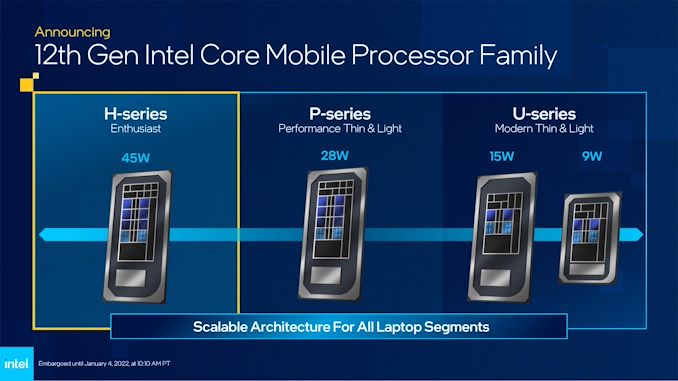








153 Comments
View All Comments
lmcd - Wednesday, January 26, 2022 - link
Ryzen 6000 does not exist as of 1/26/2022.Your analogy is awful but ironically correct -- comparable European/Japanese sports cars also get horrifying mileage, and the performance gap is in the nonsense territory with fanboys on either side debating what the immeasurable differences mean.
Spunjji - Thursday, January 27, 2022 - link
👆PeachNCream - Friday, January 28, 2022 - link
Its always funny to watch people.try to compare computers to cars. That literally happens all of the time in the tech industry and rarely fits the situation because, well obviously, computers are not cars.TheinsanegamerN - Friday, January 28, 2022 - link
It's always funny to watch people complain about car comparisons simply because "well cars and computers are different" without any other context. Tells me you have no real counterargument.cowymtber - Tuesday, January 25, 2022 - link
Tim from HUB...Do your power normalization magic, and release the demons!Timoo - Tuesday, January 25, 2022 - link
I haven't really seen the comment floating around yet.SInce Intel got bumped by Apple, could this design be their result out of a failed collaboration?
I mean, they planned to bring this design, say, 3 to 5 years ago, for Apple MacBooks etc.
But Apple -meanwhile- was thinking they could do better by themselves?
So, now Intel had their Big.Little design, in co-op with Apple, and nowhere to go but to the x86 market in full-force. Not backed by the idea that they would also end up in the Apple store...
Brett Howse - Tuesday, January 25, 2022 - link
Not likely. Apple is a big customer, but not Intel's biggest.Timoo - Tuesday, January 25, 2022 - link
Ok, I just found it kind of "coincidential" that a year after we got the news Apple has dumped Intel for their own M1, Intel comes with a "similar" design. Which must have been in development already since -say- 2016 or 2017.Maybe I have to search it in the area of thinking along with the ARM train, where Big.Little is normal, and Intel realising they have Big.Little for x86 laying around (Atom + Core). I just got the impression that it was Apple who might have triggered this idea with Intel...
But then again; that would bring a lot of Queensize Drama to this release (the failed Intel-Apple chip). And I love drama. So I am biased, presumably :-D
Thanks for your reply!
IntelUser2000 - Wednesday, January 26, 2022 - link
No, the hybrid combo was first presented by Intel back in 2005 or so by then-CTO Justin Rattner.https://images.anandtech.com/reviews/tradeshows/ID...
It might have been first at Intel if they didn't have a braindead management and CEO and executed on 10nm.
lmcd - Wednesday, January 26, 2022 - link
Intel probably started work closer to 2012. The roadmap for Atom has been converging toward serving as a desktop/laptop small core since the smartphone Atoms got canned and tablet got deprioritized. By no coincidence, that happened when Apple slammed every smartphone chip with the A7, which was also Intel's public wakeup that Apple could easily reach laptop performance on a quick timeline.